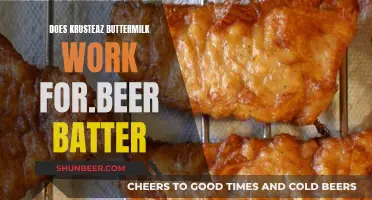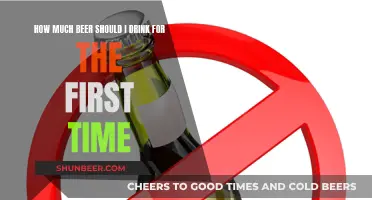
The Beer Exchange is a bar in Kalamazoo, Michigan, that has gained popularity for its unique pricing system. The bar's beer list resembles a stock ticker, with prices fluctuating in real-time based on demand, similar to a stock market. This dynamic pricing system creates an exciting and engaging experience for customers, who can purchase drinks at varying prices throughout the day. The Beer Exchange concept has also been adopted by other establishments, such as The Drink Exchange, which offers a similar model to bars and restaurants. Additionally, beer exchanges can refer to social gatherings where participants bring different beers to swap and taste, often including blind tasting elements to make it more intriguing.
| Characteristics | Values |
|---|---|
| Number of participants | Variable, but usually a large group |
| Items for exchange | Beer, usually craft beer |
| Price of items | Variable, based on real-time sales and demand |
| Location | Bars, restaurants, or private residences |
| Frequency | Variable, can be a one-time event or a permanent feature |
| Purpose | Fun, socialising, trying new beers, increasing sales and attracting customers |
| Rules | Participants bring a set number/amount of beers and contribute money to a pool for awards |
| Awards | Given for correctly identifying beers in a blind tasting |
What You'll Learn

Beer exchange as a stock market
The Drink Exchange, a software that allows bars to change drink prices in real time based on supply and demand, works like a stock market for beverages. Bars can use a big-screen TV to display a "marketplace" that resembles a stock market tracker, with drink prices fluctuating like stocks. This creates an interactive experience for patrons, who can purchase drinks at varying prices. The Drink Exchange is a dynamic pricing system designed to increase profit, attract customers, and create an exciting and dynamic environment.
The "stock market" for drinks is based on the principle of supply and demand, with prices changing according to market demand. For example, if a group of patrons enters a bar and they all order Bud Light, the demand for that beer increases. If it crosses a threshold set by the bar owner, The Drink Exchange will raise the price of Bud Light and lower that of another beer with less demand.
Bar owners have complete control over the dynamic pricing parameters, setting minimum and maximum prices for drinks and scheduling "crashes" or major discounts to keep patrons engaged. The Drink Exchange integrates with the bar's Point of Sales System, making it easy for bartenders to ring up drinks without any math involved.
The Drink Exchange also offers a mobile app that allows patrons to view current drink prices at any time and place. This viral marketing method helps attract more customers to the bar. The system connects to TVs via HDMI, VGA, or wirelessly, and some establishments also display drink prices on scrolling LED signs.
The Drink Exchange's algorithm is the key to its success, changing drink prices according to market demand and helping bar owners increase profits and push inventory. It is a unique concept that draws patrons to the bar, leading to increased patronage and profits. The system is easy to set up and can be customised to the bar's needs, running for specific events or happy hours, or operating 24/7.
The Drink Exchange also provides marketing support, with simple fliers to promote the unique offering. The exclusive nature of the business model, where only one bar in each city uses the system, creates a differentiated experience that maintains patron interest.
The Drink Exchange turns the traditional happy hour into a dynamic, fun, and memorable experience for patrons, while also helping bar owners increase sales and profits.
How Well Do Beer Thermoses Work?
You may want to see also

Beer exchange in a bar
The Beer Exchange in Kalamazoo, Michigan, has been making waves online for its unique approach to happy hour. The bar's beer list is displayed on a screen that resembles a stock ticker or a Bloomberg Terminal, with prices fluctuating in real time based on demand. This dynamic pricing system creates a fun and exciting experience for patrons, who can take advantage of occasional "market crashes" when beer prices drop to their lowest.
The Beer Exchange offers a wide range of rotating draught beers from around the world, including local Michigan brews. With 28 beers on tap, there's always something new and exciting to try. The bar also features a grill with a unique take on classic pub fare, offering interestingly prepared dishes made with fresh, high-quality ingredients.
The Drink Exchange is another example of a bar that utilizes dynamic pricing to create a stock market-like experience for its patrons. This system is designed to increase profits, attract customers, and create a dynamic and engaging atmosphere. Patrons can purchase drinks or food items featured on the TVs and watch the prices change in real time. The bar owner has complete control over the dynamic pricing parameters, allowing them to increase sales for high-profit items and move inventory as needed.
Beer exchanges can also refer to social events where participants bring different beers to swap and taste. These events can be a fun and easy way for beer enthusiasts to try a variety of craft beers and connect with others who share their interest. One popular format for a beer exchange is a blind tasting, where participants bring a case of beer and contribute two beers to the collective tasting. Participants then make notes and attempt to identify the different beers, with prizes awarded to those with the most correct guesses.
Millenials' Work Culture: Beer on the Job?
You may want to see also

Beer exchange in a multi-tap bar
The Beer Exchange in Kalamazoo, Michigan, has a beer list that resembles a stock ticker or a Bloomberg Terminal. The display shows the current prices for various kinds of beer, and as demand for the different types of beer changes, so do the prices. The Drink Exchange is a similar dynamic pricing system designed to increase profit, attract patrons, and create an exciting and dynamic environment.
A multi-tap bar can use a self-pour beverage wall to enable operators to run their establishments more efficiently with less staff while maximising beverage sales. The self-pour technology is versatile, allowing for the pouring of wine, cocktails, sodas, kombucha, and even cold-brew coffee, in addition to beer. Customers are issued an RFID card, which they place in a slot above the desired tap to start pouring. This technology can also be used to run a tab or pre-load a dollar amount.
The bar owner has complete control over the dynamic pricing parameters, and the Drink Exchange integrates directly with select Point of Sales Systems. The Drink Exchange connects to TVs via HDMI, VGA, or wirelessly, and some establishments also display drink prices on a scrolling LED sign. The Drink Exchange uses a highly specialised, fully customisable algorithm to change drink prices according to market demand.
The Beer Exchange bar in Kalamazoo, Michigan, provides an innovative and exciting experience for customers by presenting beer prices in a stock ticker format, creating a unique and dynamic drinking environment.
Bottoms Up: How Do Self-Refilling Beer Cups Work?
You may want to see also

Beer exchange as a dynamic pricing system
The Beer Exchange in Kalamazoo, Michigan, has a beer list that resembles a stock ticker or a Bloomberg Terminal. It displays the current prices for various kinds of beer, and as demand for the different types fluctuates, the prices rise and fall. This dynamic pricing system is designed to increase profit, attract patrons, and create an exciting and dynamic environment.
The Drink Exchange, a Miami company, offers an algorithm-based program that makes ordering cocktails similar to playing the stock market. The software automatically raises the price of a particular drink when it is in high demand and lowers the price when it is less popular. The system also incorporates bar promotions, such as a "market crash," where all prices are significantly reduced. Television screens and LED tickers display drink prices, allowing patrons to follow the market and make orders accordingly.
Dynamic pricing, also known as surge pricing or demand pricing, aims to manage the equilibrium of supply, demand, and profitability. During periods of high demand, dynamic pricing increases prices, while during low demand, prices are reduced to match supply and maximize profitability. The concept is based on the fundamentals of supply and demand economics, with the intersection of the demand and supply curves representing the equilibrium price where buyers and sellers agree on the trade-off between price and quantity.
The Drink Exchange provides bar owners with control over dynamic pricing parameters, allowing them to increase profits and push inventory. By utilizing the algorithm, bar owners can strategically adjust drink prices according to market demand. This dynamic pricing system has been featured in various establishments, including bars and restaurants, and has been successful in increasing sales and attracting customers.
Beer Benefits for Hair: A Guide
You may want to see also

Beer exchange as a blind tasting
A beer exchange can be a fun and easy way to get a bunch of different beers. Each participant brings a case of beer, and everyone swaps. A beer exchange can also be done as a blind tasting, which can be a more impressive and fun way to enjoy and celebrate beer.
For a blind tasting beer exchange, each participant brings one case of beer and deposits a set amount of money into a pool. Each case has two beers brought to the collective, and each is part of a blind tasting. The beers are listed on a scoring sheet, and as you taste each one, you make notes and try to match them up, guessing which beers you tried from the provided list. You also rank your top beers from the exchange.
The money gathered by the group can be used to provide awards for the most beers correctly identified or for gambling purposes. This adds an extra layer of fun and competition to the beer exchange and can help to improve your palate and knowledge of different beers.
Blind tasting a beer can involve assessing four aspects: appearance, aroma, mouthfeel, and flavor. Appearance includes the color and clarity of the beer, which can provide hints about the beer's flavor and potential flaws. Aroma can be assessed through a long-distance sniff, swirling the beer, and slowly bringing it closer to your nose to detect different aromas. Mouthfeel includes carbonation, body, astringency, and creaminess, and can help determine the style and characteristics of the beer. Finally, tasting the beer helps to confirm your notes on appearance and aroma and allows you to pinpoint off-flavors.
Beer Science: Brewing Basics and Beyond
You may want to see also
Frequently asked questions
A beer exchange is a bar or event where beer is priced according to real-time sales, mimicking a stock market. Beer prices fluctuate based on demand, and there may be occasional "market crashes" where prices drop to their lowest.
At a beer exchange, the prices of beers change dynamically based on demand. As certain beers become more popular, their prices rise, while less popular beers become cheaper. Patrons can purchase drinks at the displayed prices and watch the prices fluctuate over time.
A beer exchange creates a unique and dynamic environment that increases customer engagement and attracts patrons. It also provides an opportunity to increase profits, as items listed on the exchange tend to sell at a higher rate. Additionally, liquor distributors may compensate bars for listing specific items in the system.







